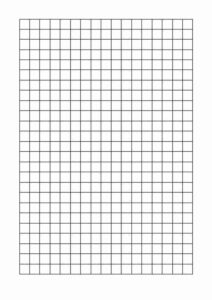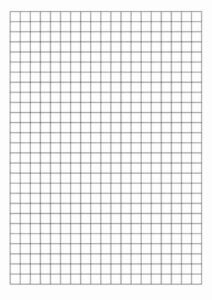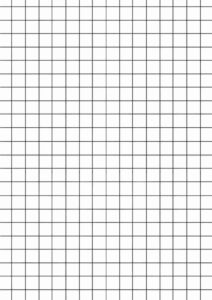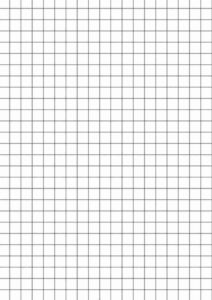Math graph paper, often associated with mathematics and engineering, is a powerful tool that goes beyond just aiding in graphing equations or drawing precise diagrams. Its structured grid of horizontal and vertical lines provides a versatile canvas for various creative endeavors, from intricate geometric designs to detailed architectural sketches. In this article, we delve into the world of math graph paper templates and explore how they can be used as a catalyst for unleashing creativity.
Math Graph Paper Template PDF:
Math graph paper is characterized by its grid layout, which typically consists of evenly spaced horizontal and vertical lines. Each intersection point of these lines forms a coordinate, allowing for precise plotting of mathematical functions, graphs, and geometric shapes. The most common types of graph paper include Cartesian coordinates (with x and y axes), polar coordinates (using radial and angular measurements), isometric graph paper (for 3D drawings), and log-log graph paper (suitable for logarithmic scales).
Types of Math Graph Paper Templates:
- Cartesian Graph Paper:
- Standard Cartesian graph paper features perpendicular x and y axes, making it ideal for plotting linear equations, functions, and data points.
- Variations include graph paper with different scales (such as larger grids for easier readability or smaller grids for more detailed plotting) and specialized versions like semi-logarithmic paper (linear x-axis with logarithmic y-axis) for exponential functions.
- Polar Graph Paper:
- Polar coordinates are represented by concentric circles (radius) and angular measurements (θ). Polar graph paper facilitates plotting curves and equations based on this coordinate system, commonly used in trigonometry and physics.
- Users can experiment with various radian intervals and circle diameters on polar graph templates, exploring the intricacies of circular functions and curves.
- Isometric Graph Paper:
- Isometric graph paper introduces a three-dimensional aspect with equally spaced lines forming equilateral triangles. This grid is utilized for creating 3D drawings, architectural sketches, and spatial designs.
- Artists and architects leverage isometric templates to visualize objects in three dimensions, fostering creativity in conceptualizing structures and layouts.
- Log-Log Graph Paper:
- Logarithmic scales, prevalent in scientific and engineering disciplines, are accommodated by log-log graph paper. This type of paper facilitates plotting data that follow exponential or power-law relationships.
- Engineers, researchers, and analysts use log-log templates for analyzing trends, plotting functions like power laws or exponential growth/decay, and understanding data with large variations in magnitude.
Creative Applications of Math Graph Paper Templates Word
1. Art and Design
Math graph paper serves as a fundamental tool for artists and designers seeking precision and structure in their creations. Here are some ways graph paper templates inspire artistic endeavors:
- Geometric Patterns: The grid layout of graph paper encourages the creation of intricate geometric patterns, tessellations, and symmetrical designs. Artists can experiment with shapes, angles, and repetitions, resulting in visually captivating artworks.
- Mosaics and Pixel Art: Using each grid square as a pixel, artists can craft pixelated images and mosaics with remarkable detail. This technique is popular in digital art and crafting, allowing for meticulous composition and color coordination.
- Architectural Sketches: Architects and designers utilize isometric graph paper to sketch floor plans, building layouts, and urban designs in three dimensions. The grid aids in maintaining scale and perspective, enhancing the accuracy of conceptual drawings.
2. Mathematics and Science
Graph paper is an indispensable tool in mathematical and scientific disciplines, enabling precise graphing, data analysis, and problem-solving. Its applications extend to various fields:
- Graphing Functions: Students and professionals use Cartesian graph paper to plot functions, equations, and data points, facilitating the visualization of mathematical concepts such as lines, curves, and transformations.
- Trigonometric Graphs: Polar graph paper is instrumental in graphing polar functions, including sinusoidal curves (e.g., sine and cosine waves) and other polar equations encountered in trigonometry and physics.
- Engineering Drawings: Isometric graph paper aids engineers in drafting technical drawings, schematics, and mechanical designs with accurate proportions and spatial relationships.
- Data Analysis: Log-log graph paper assists scientists and analysts in plotting data with exponential or logarithmic trends, making it easier to interpret patterns, correlations, and growth rates.
3. Education and Learning Tools
Graph paper templates play a vital role in education by providing visual aids, practice sheets, and instructional resources for students across various grade levels and subjects:
- Math Exercises: Teachers use graph paper worksheets for teaching coordinate geometry, algebraic graphing, and geometric transformations. Students practice plotting points, drawing lines, and exploring mathematical relationships.
- Geometry Constructions: Geometry students utilize graph paper to construct geometric shapes, angles, and proofs, reinforcing spatial reasoning and geometric concepts through hands-on activities.
- Science Experiments: Science educators incorporate graph paper in laboratory activities for graphing experimental data, analyzing trends, and presenting findings in a structured format.
- Problem Solving: Graph paper templates aid students in visualizing word problems, organizing information, and solving mathematical problems step by step, fostering critical thinking and problem-solving skills.
Tips for Using Math Graph Paper Effectively
To maximize the utility of math graph paper templates and enhance creative output, consider the following tips:
- Choose the Right Paper Type: Select the appropriate graph paper (Cartesian, polar, isometric, log-log) based on your intended application and the nature of the data or designs you plan to create.
- Use Color and Contrast: Incorporate color pens, markers, or pencils to differentiate elements, highlight patterns, and add visual appeal to your graphs, diagrams, or artworks.
- Experiment and Iterate: Don’t hesitate to experiment with different grid sizes, scales, and orientations. Iterative refinement often leads to innovative solutions and improved visualizations.
- Combine Techniques: Combine multiple graph paper types or integrate digital tools to leverage the strengths of each approach. For instance, sketching a preliminary design on isometric paper before refining it digitally can streamline the creative process.
- Embrace Mistakes: View mistakes as learning opportunities and catalysts for creativity. Sketching, erasing, and refining ideas on graph paper fosters a mindset of exploration and experimentation.
Conclusion
Math graph paper templates transcend their traditional role as tools for mathematical calculations and graphing. They serve as versatile platforms for artistic expression, scientific exploration, educational reinforcement, and problem-solving across diverse disciplines. By harnessing the structured grids and visual clarity of graph paper, individuals can unlock their creativity, visualize complex concepts, and communicate ideas effectively. Whether you’re an artist, student, scientist, or designer, math graph paper remains a timeless ally in transforming ideas from abstraction to reality.
![Free Printable Graph Paper Online [PDF Download] ✅ ❤️](https://igraphpaper.com/wordpress/wp-content/uploads/2024/04/igraphpaper-logo.png)




